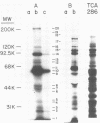Abstract
Characterization of immunogenic Trichomonas vaginalis membrane proteins was accomplished by using extrinsically and intrinsically labeled organisms and a highly sensitive and specific radioimmunoprecipitation procedure. Intact motile trichomonads were compared with detergent extracts as a source of antigen in radioimmunoprecipitation experiments. Approximately 20 proteins accessible to antibody were identified and ranged in molecular weight from 200,000 to 20,000. Localization on the parasite surface of the highly immunogenic membrane proteins was attempted by using, as the indicator system, formaldehyde-fixed protein A-bearing Staphylococcus aureus pretreated with the various antiserum reagents and incubated with live, motile parasites. Also, indirect immunofluorescence with fluorescein isothiocyanate--anti-rabbit immunoglobulin was also employed after incubation of organisms with either control serum or antiserum from immunized rabbits or after treatment of trichomonads with the immunoglobulin G fraction from each respective serum. No immunoglobulin G antibody appeared to be directed at the anterior trichomonal flagella or the posterior axostyle, whereas strong fluorescence was detected throughout the rest of the T. vaginalis surface. The biological significance of these data is discussed.
Full text
PDF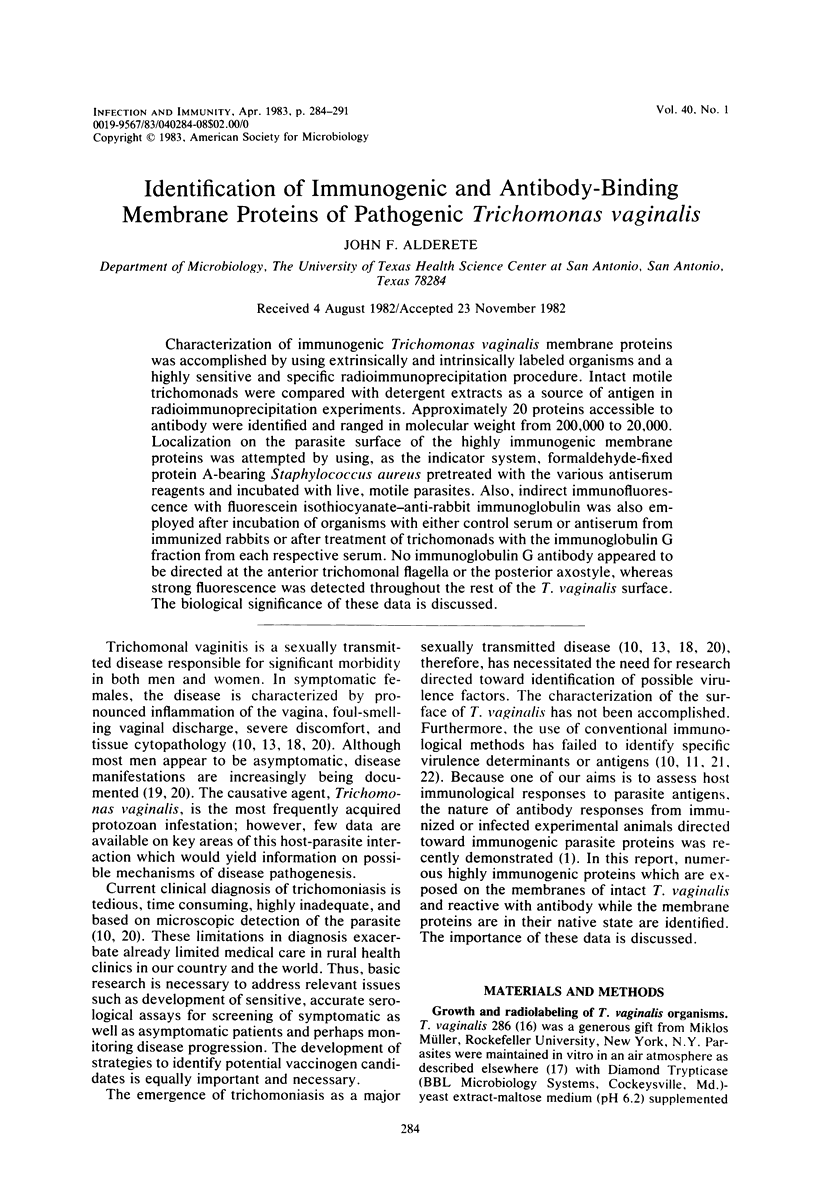
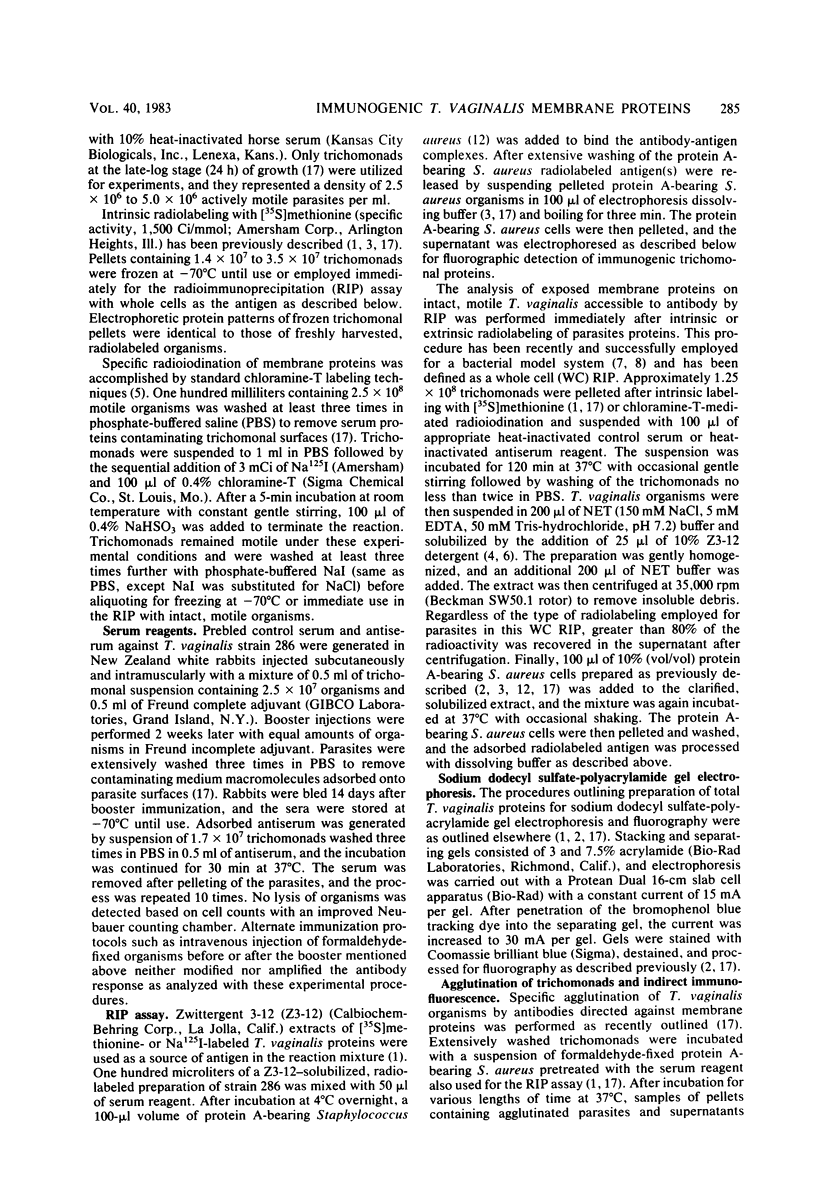
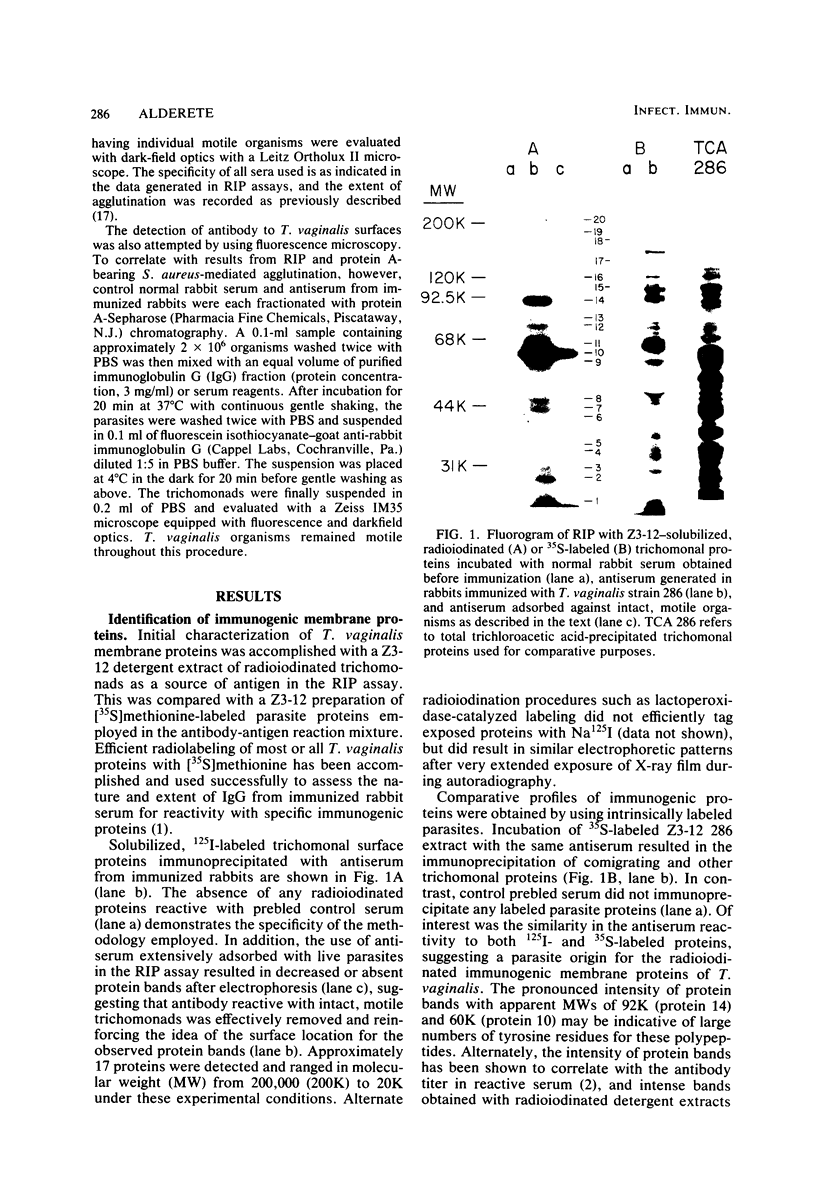
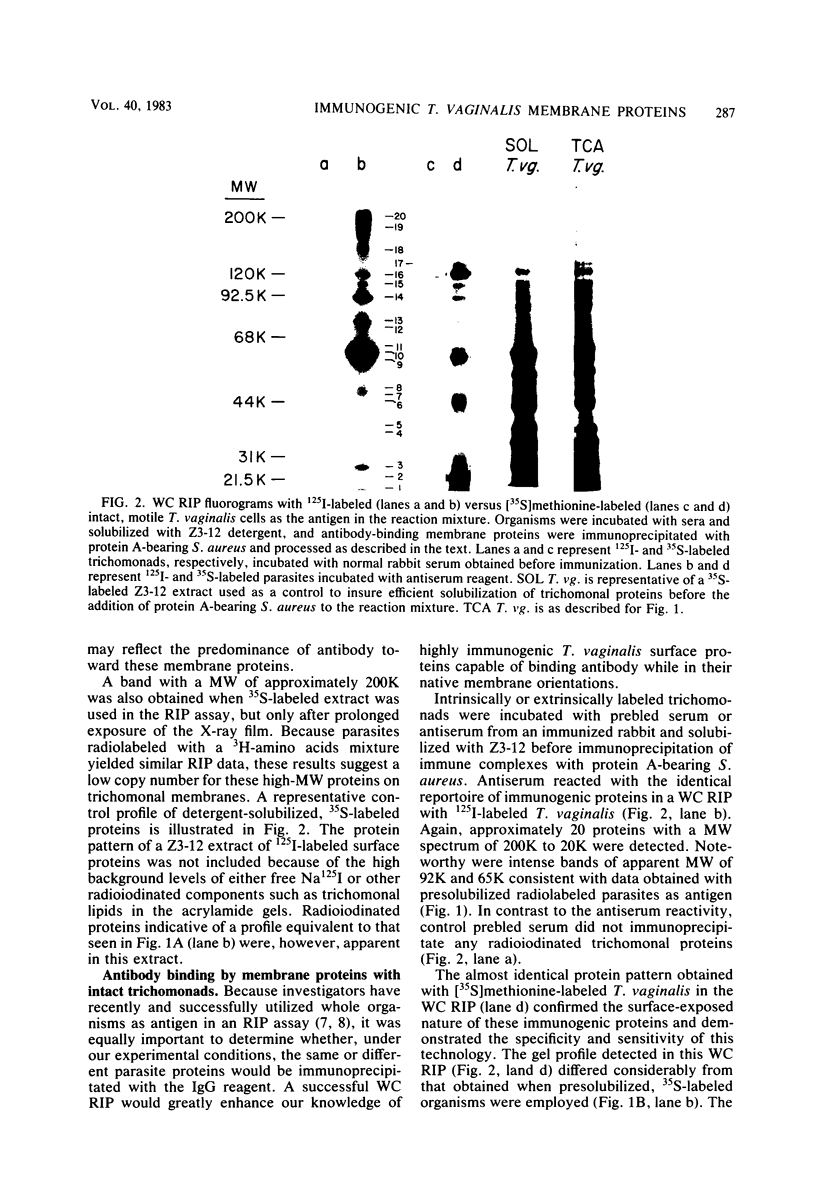
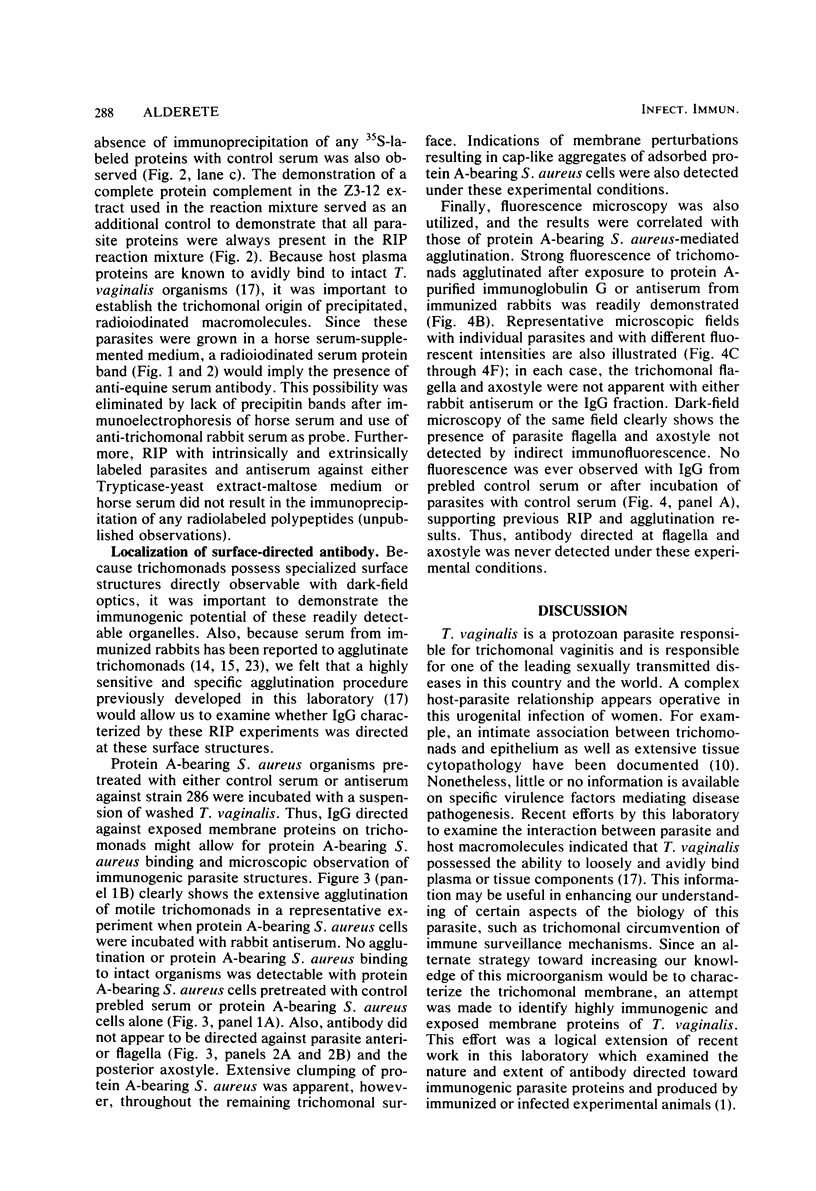
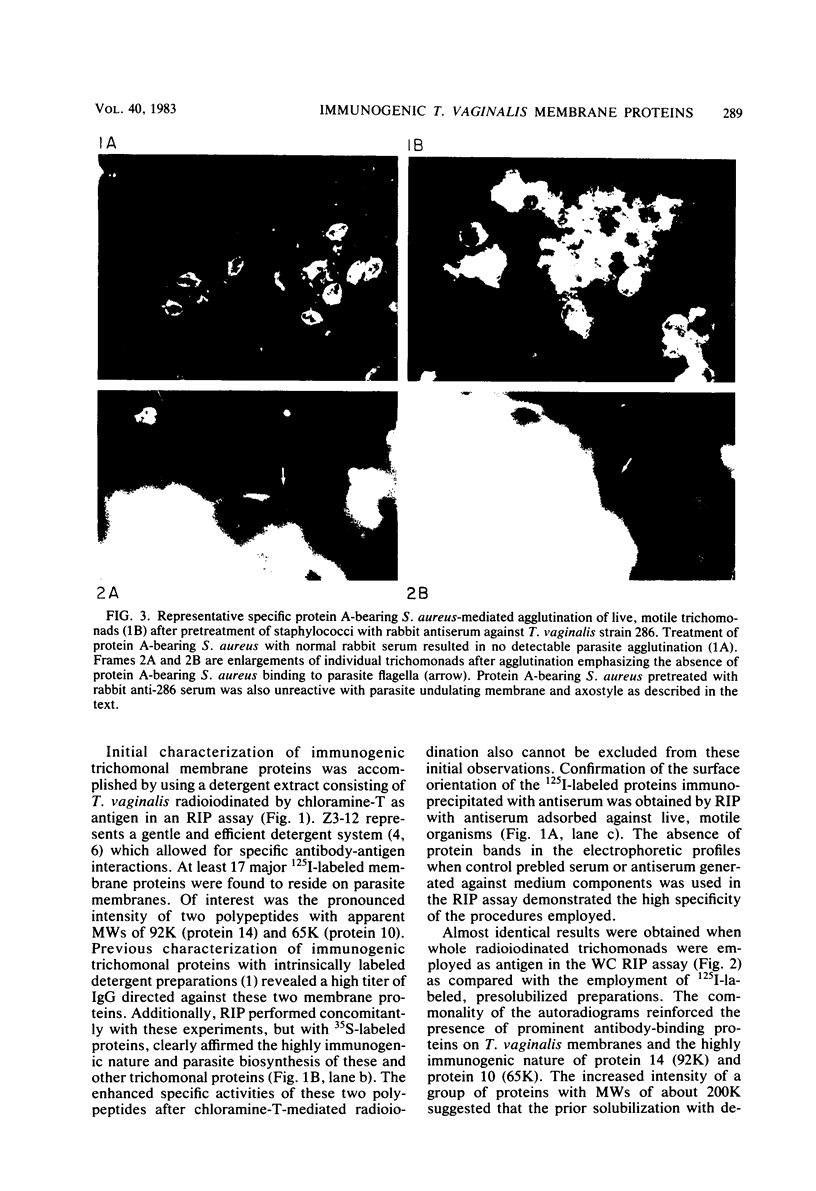

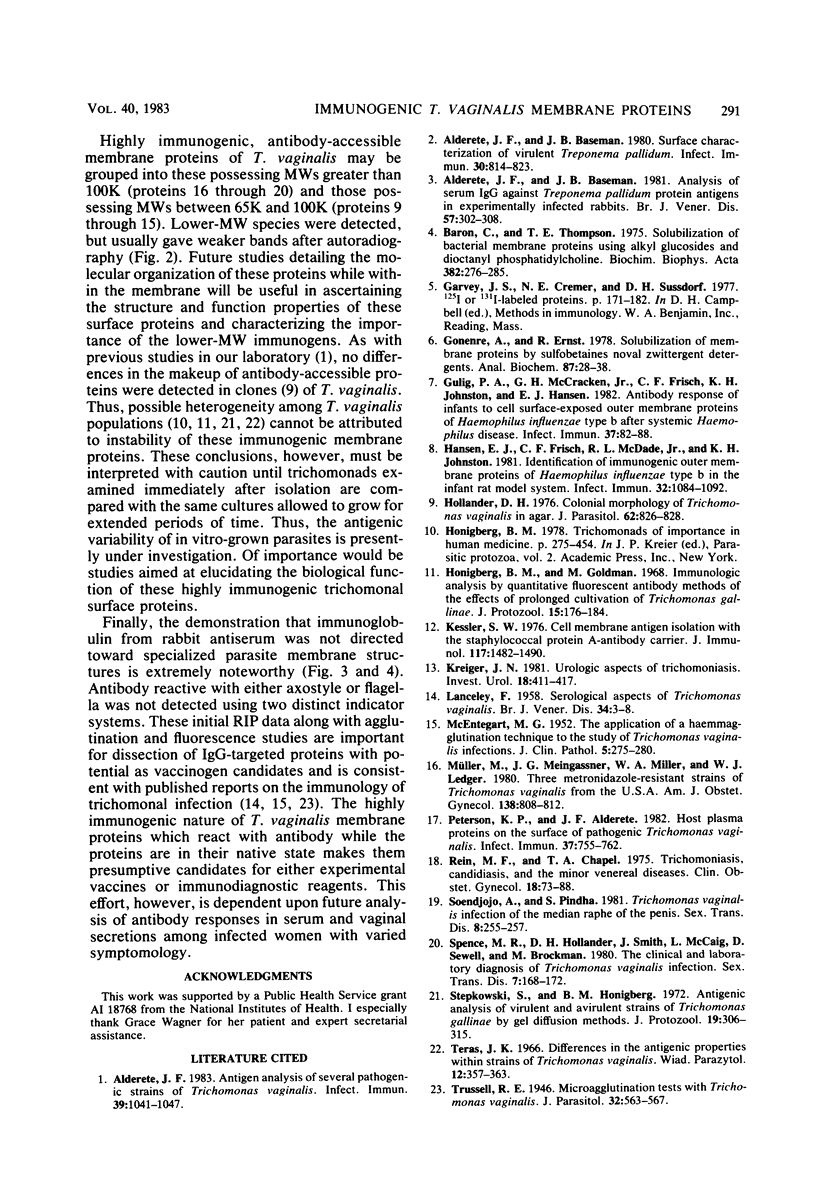
Images in this article
Selected References
These references are in PubMed. This may not be the complete list of references from this article.
- Alderete J. F. Antigen analysis of several pathogenic strains of Trichomonas vaginalis. Infect Immun. 1983 Mar;39(3):1041–1047. doi: 10.1128/iai.39.3.1041-1047.1983. [DOI] [PMC free article] [PubMed] [Google Scholar]
- Alderete J. F., Baseman J. B. Analysis of serum IgG against Treponema pallidum protein antigens in experimentally infected rabbits. Br J Vener Dis. 1981 Oct;57(5):302–308. doi: 10.1136/sti.57.5.302. [DOI] [PMC free article] [PubMed] [Google Scholar]
- Alderete J. F., Baseman J. B. Surface characterization of virulent Treponema pallidum. Infect Immun. 1980 Dec;30(3):814–823. doi: 10.1128/iai.30.3.814-823.1980. [DOI] [PMC free article] [PubMed] [Google Scholar]
- Baron C., Thompson T. E. Solubilization of bacterial membrane proteins using alkyl glucosides and dioctanoyl phosphatidylcholine. Biochim Biophys Acta. 1975 Mar 25;382(3):276–285. doi: 10.1016/0005-2736(75)90270-9. [DOI] [PubMed] [Google Scholar]
- Gonenne A., Ernst R. Solubilization of membrane proteins by sulfobetaines, novel zwitterionic surfactants. Anal Biochem. 1978 Jun 15;87(1):28–38. doi: 10.1016/0003-2697(78)90565-1. [DOI] [PubMed] [Google Scholar]
- Gulig P. A., McCracken G. H., Jr, Frisch C. F., Johnston K. H., Hansen E. J. Antibody response of infants to cell surface-exposed outer membrane proteins of Haemophilus influenzae type b after systemic Haemophilus disease. Infect Immun. 1982 Jul;37(1):82–88. doi: 10.1128/iai.37.1.82-88.1982. [DOI] [PMC free article] [PubMed] [Google Scholar]
- Hansen E. J., Frisch C. F., McDade R. L., Jr, Johnston K. H. Identification of immunogenic outer membrane proteins of Haemophilus influenzae type b in the infant rat model system. Infect Immun. 1981 Jun;32(3):1084–1092. doi: 10.1128/iai.32.3.1084-1092.1981. [DOI] [PMC free article] [PubMed] [Google Scholar]
- Hollander D. H. Colonial morphology of Trichomonas vaginalis in Agar. J Parasitol. 1976 Oct;62(5):826–828. [PubMed] [Google Scholar]
- Honigberg B. M., Goldman M. Immunologic analysis by quantitative fluorescent antibody methods of the effects of prolonged cultivation on Trichomonas gallinae. J Protozool. 1968 Feb;15(1):176–184. doi: 10.1111/j.1550-7408.1968.tb02107.x. [DOI] [PubMed] [Google Scholar]
- Kessler S. W. Cell membrane antigen isolation with the staphylococcal protein A-antibody adsorbent. J Immunol. 1976 Nov;117(5 Pt 1):1482–1490. [PubMed] [Google Scholar]
- Krieger J. N. Urologic aspects of trichomoniasis. Invest Urol. 1981 May;18(8):411–417. [PubMed] [Google Scholar]
- LANCELEY F. Serological aspects of Trichomonas vaginalis. Br J Vener Dis. 1958 Mar;34(1):4–8. doi: 10.1136/sti.34.1.4. [DOI] [PMC free article] [PubMed] [Google Scholar]
- McENTEGART M. G. The application of a haemagglutination technique to the study of Trichomonas vaginalis infections. J Clin Pathol. 1952 Aug;5(3):275–280. doi: 10.1136/jcp.5.3.275. [DOI] [PMC free article] [PubMed] [Google Scholar]
- Müller M., Meingassner J. G., Miller W. A., Ledger W. J. Three metronidazole-resistant strains of Trichomonas vaginalis from the United States. Am J Obstet Gynecol. 1980 Dec 1;138(7 Pt 1):808–812. doi: 10.1016/s0002-9378(16)32741-7. [DOI] [PubMed] [Google Scholar]
- Peterson K. M., Alderete J. F. Host plasma proteins on the surface of pathogenic Trichomonas vaginalis. Infect Immun. 1982 Aug;37(2):755–762. doi: 10.1128/iai.37.2.755-762.1982. [DOI] [PMC free article] [PubMed] [Google Scholar]
- Rein M. F., Chapel T. A. Trichomoniasis, candidiasis, and the minor venereal diseases. Clin Obstet Gynecol. 1975 Mar;18(1):73–88. doi: 10.1097/00003081-197503000-00008. [DOI] [PubMed] [Google Scholar]
- Soendjojo A., Pindha S. Trichomonas vaginalis infection of the median raphe of the penis. Sex Transm Dis. 1981 Oct-Dec;8(4):255–257. doi: 10.1097/00007435-198110000-00003. [DOI] [PubMed] [Google Scholar]
- Spence M. R., Hollander D. H., Smith J., McCaig L., Sewell D., Brockman M. The clinical and laboratory diagnosis of Trichomonas vaginalis infection. Sex Transm Dis. 1980 Oct-Dec;7(4):168–171. doi: 10.1097/00007435-198010000-00004. [DOI] [PubMed] [Google Scholar]
- Stepkowski S., Honigberg B. M. Antigenic analysis of virulent and avirulent strains of Trichomonas gallinae by gel diffusion methods. J Protozool. 1972 May;19(2):306–315. doi: 10.1111/j.1550-7408.1972.tb03465.x. [DOI] [PubMed] [Google Scholar]



